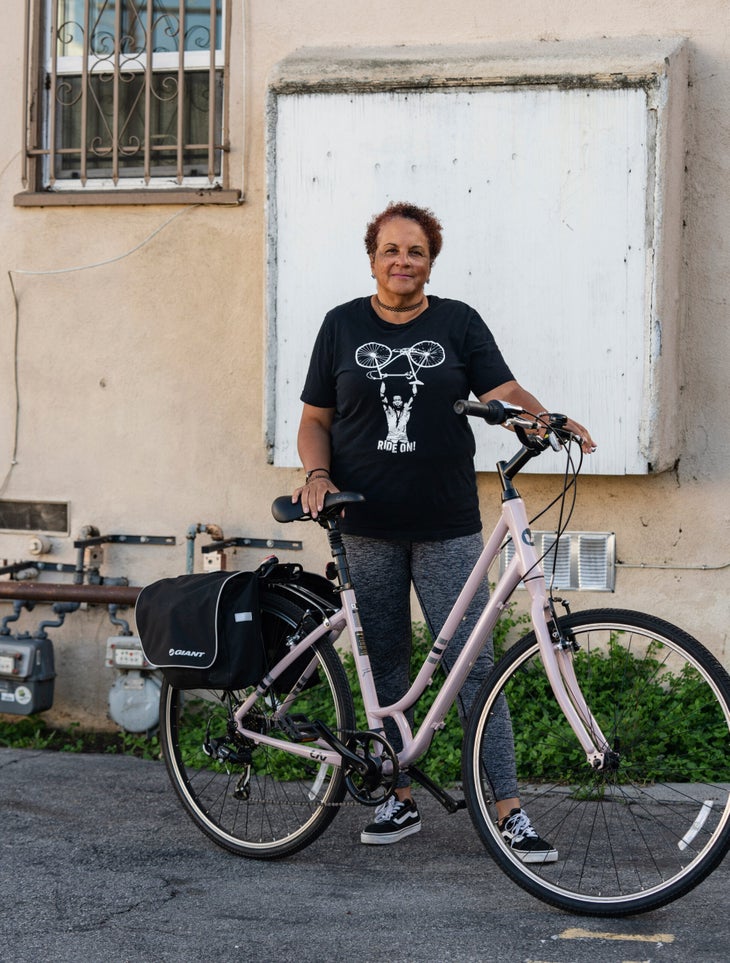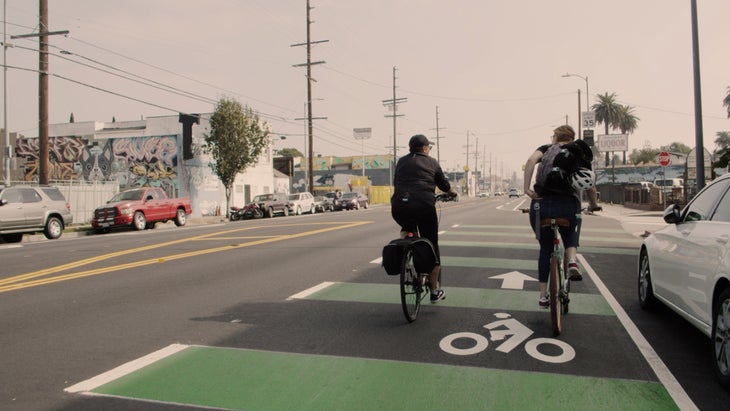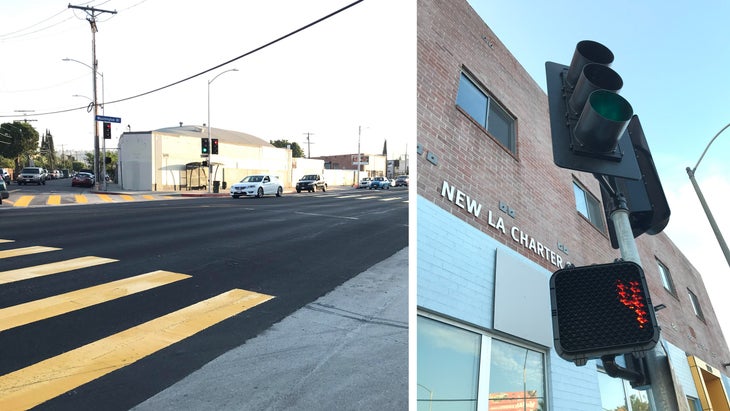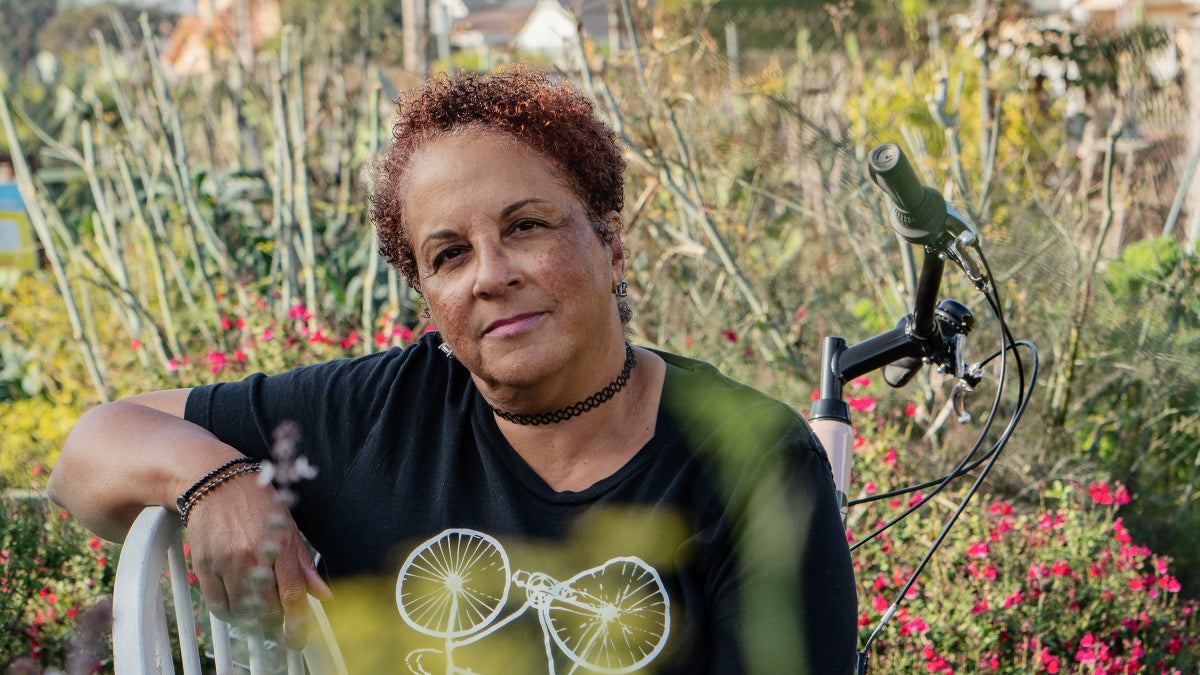No products in the cart.
Outdoor Adventure
This L.A. Resident Is Working to Stop Pedestrian and Cyclist Deaths in Her Neighborhood
The welter of Interstate 10 drowns out Yolanda Davis-Overstreet’s voice as we pedal beneath an ivy-laced underpass on the cusp of South L.A. I’m following her mauve city bike north on Redondo—we’ve just left West Adams Boulevard, the main drag through her childhood stomping grounds of the same name—and we’re heading for New Los Angeles Charter Middle School, about half a mile away as the crow flies. After her daughter, Niah, began sixth grade there in 2013, Davis-Overstreet led a grassroots campaign urging the city to install pedestrian infrastructure at the dangerous intersection in front of the school.
Today the 61-year-old is vibrant in cyan beaded earrings, Vans, and brow-line glasses, with a nineties-style choker coiled around her neck and a black ball cap tucked over tight, dyed burgundy curls. She isn’t wearing a helmet; while she normally does opt for one, personal-safety gear offers little in the face of the systemic problems she’s fighting. Besides, the lifelong cyclist knows which streets to avoid pedaling down in the place where she was born and raised.
Davis-Overstreet grew up roaming this largely Black (and later Latino) area, located about eight miles east of Santa Monica, on a gold banana-seat high-riser with ape-hanger handlebars. As an adult, she fell in with L.A.’s Black road-cycling community and eventually found her calling in mobility justice, an endeavor that seeks to make communities of color safer for those moving around within them. For many people who rent or own homes in marginalized areas, walking or biking is the only transportation option, but infrastructure for those on foot or on two wheels, such as crosswalks, bike lanes, and even sidewalks, is often absent. The problem is worse for the unhoused, who have little choice but to spend all of their time on these dangerous streets.
In the U.S. at large, a pedestrian dies every 90 minutes. Such deaths occur twice as often in neighborhoods where the median per capita income is less than $21,000. In L.A., Black residents account for 18 percent of collision victims, despite comprising only about 8 percent of the city’s population. Seventy percent of serious injuries and fatalities are clustered on just 6 percent of the city’s streets, most of which are located in Black or Latino neighborhoods.
A community organizer and strategist, Davis-Overstreet holds a master’s degree in urban sustainability from nearby Antioch University. She has collaborated on a wide range of projects, from pushing for bike lanes and crosswalks on high-risk streets to helping the city develop policies for zero-emission zones to improving access to local parklands in the community of Baldwin Hills. “We’ve been told to get at the back of the line since we came to America,” Davis-Overstreet tells me. “That’s actually what I was told—that to advocate for safe streets for New Los Angeles Charter Middle School, I had to get to the back of the line with everyone else. But my process is not working within the system.”
In 2011 she founded the platform Ride in Living Color, which educates people about mobility justice and the history of African American cyclists, such as Marshall “Major” Taylor, nicknamed the Black Cyclone, who set multiple world records in the late 19th and early 20th centuries despite death threats, intimidation, and physical attacks that attempted to slow him down. Ride in Living Color also brings people together for social rides, at times 40 to 50 bicyclists strong. “It was like, this is the remedy,” says Davis-Overstreet, recalling when she first started them. “This is the solution—everybody just get out on a bike and let’s ride.”

West Adams Boulevard is one of the most dangerous streets in all of L.A. in terms of traffic fatalities. From 2009 to 2019, at least 45 cyclists were hit here, and six pedestrians were killed, including Jihad Muhammad. On Thanksgiving Day in 2019, the unhoused cancer survivor was struck while walking on the street, then hit again by another vehicle, and finally dragged by a third car 13 blocks to a gas station, where he died. All three drivers fled.
In collaboration with the L.A. Department of Transportation’s Vision Zero project, which seeks to eliminate traffic deaths by 2025, Davis-Overstreet has worked to educate residents about the safety issues on West Adams Boulevard. “Community support is critical,” says Lauren Ballard, a transportation planner for the LADOT. “Yolanda’s advocacy and leadership have been key to successful community engagement and support for the project.”
Earlier in the day, Davis-Overstreet showed me the fruits of Vision Zero’s efforts on West Adams, which is peppered with small galleries and eateries, from hole-in-the-wall taquerias to a trendy, upscale soul-food restaurant slinging $16 cocktails. The city recently plastered the formerly potholed, four-lane road with newly minted bike lanes. The success of this effort will be measured by the number of fatalities that occur on West Adams Boulevard, but Davis-Overstreet secured additional resources beyond the project’s original scope, which has already improved the streetscape in myriad ways: Regular street sweeping largely clears the gutters of the Chick-fil-A detritus and beer bottles I’d seen strewn in other areas. And Chinese elm and other saplings, which will ultimately provide shade and absorb noise, have begun to take root in the hell strips between the street’s lanes. Already, Davis-Overstreet told me, it feels different.
Instead of ripping past clusters of unhoused people at 50 miles per hour—a crush of traffic that sounded “almost like a wave,” according to Davis-Overstreet—vehicles now motor down the street at around 35. Still, as we cruised past a skate shop and a bookstore with freshly graffitied windows, a muscle car startled us as it burned rubber down the middle turn-only lane to bypass slow traffic. Near a café strewn with copies of El Aviso, a Spanish-language general-interest magazine, a man dashed across the lanes, threading the gap with a baby in his arms. Elsewhere, a Pepto Bismol–pink ice cream truck trawled the eastbound bike lane, emitting a discordant jingle, and passenger vehicles swerved into it, too, employing it as a makeshift passing lane. Drivers weren’t used to the new setup.

Communities of color—even historically affluent ones like West Adams—are often treated as places to be driven through instead of thriving communities in their own right. The Federal Aid Highway Act of 1956, which created the interstate system as we know it today, established freeways that cut through many neighborhoods of color. In 1960, the year Davis-Overstreet was born, her parents received a notice that their West Adams rental was among the hundreds of houses slated to be razed to make way for the new Interstate 10. “There was no fee involved in helping them to relocate,” says Davis-Overstreet. “They were given a certain amount of time that they had to move, and then they moved.”
In addition to the homes and community spaces lost to these projects, the interstate system created physical boundaries that reinforced the marginalization of such neighborhoods. Many of these areas had already begun to face disinvestment as a result of redlining, a practice that started after Great Depression that excludes home buyers in Black neighborhoods from federally backed mortgages. (Neighborhoods that were deemed risky investments—generally, that is, communities of color—were coded red on internal maps and subsequently segregated from government-subsidized white-only suburbs.) Of course, new roadways also routed more traffic through these communities. Today, frustrated commuters still speed through many of West Adams’s streets trying to avoid bumper-to-bumper jams on the freeway.
Communities of color—even historically affluent ones like West Adams—are often treated as places to be driven through instead of thriving communities in their own right.
Walking and biking would help ameliorate many of these interconnected problems: too many cars on L.A.’s clogged streets; air pollution that disproportionately harms communities of color; physical ailments that inordinately affect Black people, including hypertension and obesity (especially among Black women). But while pedestrian and cycling infrastructure would help cure some of the symptoms of disinvestment in communities of color, mobility justice also has to address the complex, cascading roots of institutional racism in housing, public health, and policing. Simply being in public while Black is a roll of the dice. Take Dijon Kizzee, a 29-year-old Black man who was killed by L.A. County sheriff’s deputies in 2020 after they attempted to stop him while biking.
Or take Adé Neff, a dapper, soft-spoken transplant who who rented me a bike the day before my ride with Davis-Overstreet. In 2014, he founded a worker-owned bike co-op called Ride On in the lively heart of Leimert Park, a predominantly Black neighborhood near West Adams. A former classmate of Davis-Overstreet at Antioch, Neff told me he had recently been pulled over on his bike while cycling on West Adams Boulevard. Legally, nothing ever came of the stop. But Neff spent the weekend in jail, and when he tried to recover his electric bike, which had been impounded, he found that it had disappeared.
For years, Neff didn’t own a car. The safest route from his residence in Hollywood to Venice Beach, which he commuted daily in street clothes, passed through the residential streets of Beverly Hills. “Like clockwork, I got pulled over damn near every day,” he told me. Neff has friends who wear spandex to try and avoid being singled out. If police “notice that you’re Black, but you have this kit on with a $10,000 bike,” you might get a pass, he says. “But if I look like this”—Neff was wearing red-and-yellow sneakers and an emerald-hued tee stating “Black Power Ride On!”—“and I’m on a $10,000 bike, whether I bought it or not, I fit the description.”
For Davis-Overstreet, addressing police abuse toward people who “fit the description”—men who look like Neff, or like her son, Nile—is part of the snaggled web of mobility justice. To make public spaces safer for Black men and for all people of color is also to build a culture of care toward the environment. “Our communities can be strong stewards for the planet, but people are afraid for their lives,” she says. “How can we become mountaineers? How can we become Olympians? How can we get there if we’re too frightened to even come outside our door?”

Community-led initiatives are a step in the right direction. As we coast to a stop across from New Los Angeles Charter Middle School, on the other side of I-10, Davis-Overstreet tells me that she took hundreds of photos and videos to document the dangerous street conditions here.
In 2015, the LADOT responded to her and other activists’ lobbying by approving safety upgrades for the high-speed intersection in front of the school, which didn’t even have a traffic signal. But they took five years to actually be implemented. While the project was awaiting funding, a mother and her three-month-old were seriously injured here. A month later, in August of 2019, there was another grisly accident, close to where we’re taking a breather now.
As we survey the yawning intersection on this sunny October afternoon, Davis-Overstreet’s hard-won additions seem like a drop in the bucket: four broad, yolk-yellow crosswalks; a set of traffic lights in each direction; some school signage. And yet instead of roaring by, cars idle beside us at the light. I can finally hear Davis-Overstreet clearly. She’s circled back to a story she told me earlier, about a century ride she did from Anaheim to San Diego in her forties, during which she was left behind by her friends. The chase truck crawled along beside her, proffering Gatorade and waiting for her to give in as she climbed into Torrey Pines. Not today, she recalls thinking. She cracks up at the recollection.
“You are going to be out there, sometimes, on your own,” she continues, now in a more serious tone. “That’s the thing about bicycling—nobody can help you pedal.”
Source link

